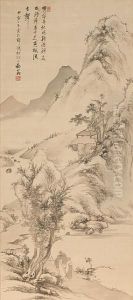Nukina Kaioku Paintings
Nukina Kaioku was a prominent Japanese painter, calligrapher, and poet during the late Edo period. Born in 1778 in Iyo province (present-day Ehime prefecture), Kaioku established himself as a multifaceted artist deeply influenced by Chinese culture, which was fashionable among the intellectual elite of Japan during his lifetime.
Kaioku's artistic journey began under the tutelage of his father, Nukina Sukenao, who was also a skilled calligrapher. As he honed his calligraphic skills, Kaioku furthered his studies under the guidance of other prominent artists of the time, including Tani Bunchō, a painter who was instrumental in the introduction of the Chinese literati painting style (Nanga or Bunjinga) to Japan. Kaioku is particularly known for his mastery of this style, which emphasizes scholarly and personal expression over formalized techniques.
Throughout his career, Kaioku established a reputation not only as an artist but also as a teacher and a connoisseur of Chinese art and literature. He founded the Baiitsu-an, a private school where he instructed many students in the ways of literati culture. His extensive knowledge of Chinese classics and his mastery of calligraphy made him a pivotal figure in the cultural circles of his time.
Kaioku's work often reflects the aesthetics and philosophy of the literati: a deep appreciation for nature, simplicity, and the pursuit of personal expression. His paintings frequently depict traditional subjects such as landscapes, flowers, and birds with a delicate and spontaneous touch characteristic of the literati style.
After a long and influential career, Nukina Kaioku passed away in 1863. His legacy lives on through his numerous works and his impact on the development of the literati tradition in Japanese art. His style influenced subsequent generations of Japanese artists who sought to balance the pursuit of personal artistic expression with the learned traditions of the past.

